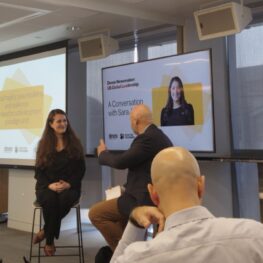I remember the first time I saw the term ‘glocalization’ and how my forefinger traced the letters of the word as I voiced it out. I was undertaking a certificate course in Human Resource Management and the concept was being linked to talent management, specifically how to strengthen local systems to attract global talent as an international brand. This could be summed up as ‘start local but think global’. This was in 2019.
Fast forward to 2023, I was sitting in an audience of 40 people or so at the Microsoft Innovation and Policy Center in Washington, DC at an event organized by Devex. Congresswoman Sara Jacobs was speaking on the US-Africa relations and her insight on shifting the power dynamics between the United States and Africa was a breath of fresh air.

Credit: Author
Multiple times she referred to the localization agenda of USAID and so I read up on it. In simple terms, it is USAID’s internal reforms to ensure that all interventions are locally led, providing humanitarian assistance that fits the priorities of local actors and accepts their ideas on how to tackle those issues. Although the term has been criticized as emerging from global north supremacy and a replacement with ‘ecosystem development’ has been suggested, I still find this pivot to be laudable. It is about time that we moved away from ‘glocalization’, where there is an unhealthy obsession with ‘global best practices’ at the detriment of international actors fully acknowledging, appreciating or even understanding local contexts. The fact that USAID does not only have this as a policy on paper but is actually following through is more than a welcome development.
The second segment of the event featured Safaa Shahin, Interim Global Risk and Resilience Director at Food for the Hungry, speaking on conflict and cultural sensitivity. Where conflict sensitivity thrives on the idea of not causing further harm in places experiencing conflict, cultural sensitivity revolves around acknowledging cultures in local contexts, respecting them and not adjudging them as either positive or negative.

Credit: Author
However, what does this look like for me as a professional in Communications and Program Development who will be returning to continue her work in Nigeria?
Truth be told, as a Nigerian, and indeed an individual from a country who has always been on the receiving end of humanitarian aid, it is easy to be like, “Finally! These people have realized that they can’t just come into my country and decide stuff for us. We should make our decisions!” Yet, the concepts of localization as well as conflict and cultural sensitivity are not to be followed by international aid workers alone. Within countries, there is so much diversity and unique contexts that require the application of sensitivity and an understanding of intersectionality.
Intersectionality is a term coined by Kimberlé Crenshaw that refers to how the interconnected nature of an individual’s identity may create multiple layers of discrimination or disadvantage. For example, being an immigrant, woman of color easily creates at least 3 points of disadvantage. These intersections create intersectionality. When I first learned the concept as an Atlas Corps Scholar in the Virtual Leadership Institute back in 2020, I remember synthesizing it as, “Nobody is only ever one thing”, and in the unjust world we live in, it means most people will always experience at least one form of disadvantage. This understanding is an important one to have in the non-profit space as we often prefer to lump each member of the communities we serve in one category, forgetting that there are vast differences in their lived experiences as a result of their locations, educational attainment, socio-economic status, family backgrounds, identities, exposure to conflict etc.
Therefore, as a development professional in any field, the framework for engaging any community always has to be human-centered. Adopting the human-centered design process popularized by IDEO puts the community needs at the center and makes them co-creators of solutions. In deploying the human-centered design process, areas requiring cultural and conflict sensitivity as well as intersectionality can be identified, and addressed in the development of various solutions. Each professional should then find where they fit in the process and plug in. And yes, you may think that this is too time-consuming but if you really want to build sustainable programs that move the needle then quit whining and put in the work!
Localization is USAID’s agenda for shifting the paradigm in international humanitarian aid but I dare to say that even locally we should get more local!



